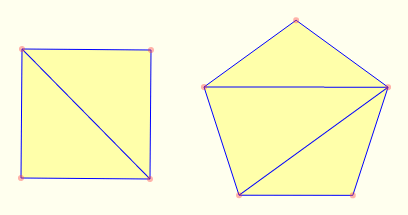Algorithm
Problem Name: 2 AD-HOC - beecrowd | 2058
Problem Link: https://www.beecrowd.com.br/judge/en/problems/view/2058
Triangles and Regular Polygons
By M.C. Pinto, UNILA  Brazil
Brazil
Timelimit: 1
Professor Rafael loves Computer Graphics. Its favourite activity is rendering objects, specially dolls. But he does not like to draw regular polygons using triangles. This task is done by composing a regular polygon using only triangles, in such a way that the triangles do not intercept each other and the minimum number of them are used in this composition. In the picture below you can see a square and a pentagon with its triangles.

Professor Rafael asked you to calculate the minimum number of triangles necessary to compose a N-sided regular polygon.
Input
The input is a single number N (3 ≤ N ≤ 109), indicating the number of sides of a regular polygon.
Output
The output is the minimum number of triangles necessary to compose an N-sided regular polygon.
| Input Samples | Output Samples |
|
3 |
1 |
Code Examples
#1 Code Example with C Programming
Code -
C Programming
#include <stdio.h>
int main (void)
{
int lados;
scanf("%d", &lados);
printf("%d\n", lados-2);
}
Input
Output
#2 Code Example with C++ Programming
Code -
C++ Programming
#include <iostream>
using namespace std;
int main() {
long long x;
cin >> x;
cout << x-2 << endl;
return 0;
}
Input
Output
#3 Code Example with Java Programming
Code -
Java Programming
import java.io.BufferedReader;
import java.io.BufferedWriter;
import java.io.Closeable;
import java.io.IOException;
import java.io.InputStream;
import java.io.InputStreamReader;
import java.io.OutputStream;
import java.io.OutputStreamWriter;
import java.io.PrintWriter;
import java.util.StringTokenizer;
public class Main {
static Reader in = new Reader(System.in);
static Writer out = new Writer(System.out);
public static void main(String[] args) throws IOException {
out.println(in.nextInt() - 2);
in.close();
out.flush();
out.close();
}
////////////////////////////////////////////////////////////////////////////
///////////////////////////// INPUT / OUTPUT /////////////////////////////
////////////////////////////////////////////////////////////////////////////
static class Reader implements Closeable {
private final BufferedReader reader;
private StringTokenizer tokenizer;
public Reader(InputStream input) {
reader = new BufferedReader(
new InputStreamReader(input));
tokenizer = new StringTokenizer("");
}
private StringTokenizer getTokenizer() throws IOException {
if (tokenizer == null || !tokenizer.hasMoreTokens()) {
String line = nextLine();
if (line == null) {
return null;
}
tokenizer = new StringTokenizer(line);
}
return tokenizer;
}
public boolean hasNext() throws IOException {
return getTokenizer() != null;
}
public String next() throws IOException {
return hasNext() ? tokenizer.nextToken() : null;
}
public String nextLine() throws IOException {
tokenizer = null;
return reader.readLine();
}
public int nextInt() throws IOException {
return Integer.parseInt(next());
}
public long nextLong() throws IOException {
return Long.parseLong(next());
}
public float nextFloat() throws IOException {
return Float.parseFloat(next());
}
public double nextDouble() throws IOException {
return Double.parseDouble(next());
}
public String[] nextStringArray(int size) throws IOException {
String[] array = new String[size];
for (int i = 0; i < size; i++) {
array[i] = next();
}
return array;
}
public int[] nextIntArray(int size) throws IOException {
int[] array = new int[size];
for (int i = 0; i < size; i++) {
array[i] = nextInt();
}
return array;
}
public long[] nextLongArray(int size) throws IOException {
long[] array = new long[size];
for (int i = 0; i < size; i++) {
array[i] = nextLong();
}
return array;
}
public double[] nextDoubleArray(int size) throws IOException {
double[] array = new double[size];
for (int i = 0; i < size; i++) {
array[i] = nextDouble();
}
return array;
}
@Override
public void close() throws IOException {
tokenizer = null;
reader.close();
}
}
static class Writer {
private final PrintWriter writer;
public Writer(OutputStream outputStream) {
writer = new PrintWriter(new BufferedWriter(new OutputStreamWriter(outputStream)));
}
public void print(Object... objects) {
for (int i = 0; i < objects.length; i++) {
if (i != 0) {
writer.print(' ');
}
writer.print(objects[i]);
}
}
public void println(Object... objects) {
print(objects);
writer.println();
}
public void close() {
writer.close();
}
public void flush() {
writer.flush();
}
}
}
Input
Output
#4 Code Example with Python Programming
Code -
Python Programming
print(int(input()) - 2)
Input
Output
